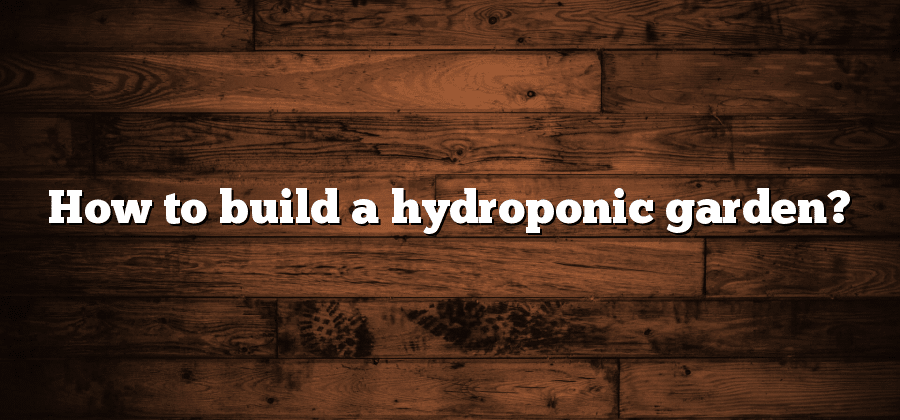Selecting the Right Hydroponic System
When it comes to hydroponic gardening, selecting the right system is a crucial first step. With numerous options available, it’s essential to understand the different types of hydroponic systems and their pros and cons. One popular choice is the drip system, which involves providing a steady flow of nutrient-rich solution to the plants’ roots. This system is known for its simplicity and versatility, making it suitable for both beginners and experienced gardeners alike. Another option is the nutrient film technique (NFT) system, where a thin film of nutrient solution continuously flows over the roots, providing them with the necessary nutrients. This system is highly efficient in water and nutrient usage, making it an eco-friendly choice. Additionally, the ebb and flow system, also known as a flood and drain system, periodically floods the growing medium with the nutrient solution, ensuring that the roots are adequately nourished. This system offers excellent flexibility and is particularly useful for larger plants or those with extensive root systems.
Choosing the Ideal Growing Medium
Hydroponic gardening provides a unique opportunity to cultivate plants without the use of traditional soil. In order to create an optimal growing environment, it is crucial to select the right growing medium. A growing medium, also known as a substrate, serves as a support system for plants’ roots, while also providing essential nutrients and allowing for proper drainage.
When choosing an ideal growing medium for a hydroponic system, there are several factors to consider. Firstly, it is important to select a medium that has good water retention capabilities. This ensures that the plants have access to sufficient moisture, allowing for proper hydration and nutrient absorption. Additionally, the medium should have adequate aeration properties, preventing the roots from becoming waterlogged and facilitating the exchange of gases within the root zone. Lastly, it is important to choose a sterile growing medium to minimize the risk of disease and pests. By selecting a suitable growing medium that meets these criteria, hydroponic gardeners can provide the ideal conditions for their plants to thrive.
Providing Adequate Lighting for Plants
To ensure optimal growth and development of plants in a hydroponic system, providing adequate lighting is crucial. Light is essential for photosynthesis, the process by which plants convert light energy into chemical energy to fuel their growth. When selecting the right lighting system for your hydroponic garden, there are several factors to consider.
First and foremost, the intensity of the light is of utmost importance. Different plants have different light requirements, and it is essential to match the lighting intensity to the specific needs of your plants. Most commonly, hydroponic gardeners opt for high-intensity discharge (HID) lights, such as metal halides or high-pressure sodiums, as they provide the necessary brightness for plants to thrive. Additionally, LED lights have gained popularity due to their energy efficiency and customizable spectrum options. It is advisable to consult a professional who can guide you in selecting the right lighting system for your specific plants and garden setup.
Nutrient Solutions for Hydroponic Gardens
Hydroponic gardens provide an efficient and controlled environment for plants to grow without the use of soil. One crucial element in the success of hydroponics is the nutrient solutions used. These solutions are specially formulated to provide the necessary nutrients for plant growth and development.
The nutrient solutions used in hydroponic gardens are carefully balanced to ensure that plants receive all the essential elements they need. These solutions typically contain a blend of macronutrients, such as nitrogen, phosphorus, and potassium, as well as micronutrients like iron, magnesium, and zinc. The concentrations of these nutrients need to be carefully monitored to prevent deficiencies or toxicities that can harm plant health. Additionally, pH levels need to be adjusted to promote nutrient absorption and optimize plant growth. Achieving the ideal nutrient balance in the hydroponic system is critical for healthy plant growth and high yields.
Setting Up the Watering System
A key component of a successful hydroponic garden is a well-designed watering system. This system plays a crucial role in providing the plants with the necessary water and nutrient solutions. When setting up your watering system, it is important to consider a few factors to ensure optimal plant growth.
Firstly, determine the type of watering system that best suits your needs. There are various options available, including drip irrigation, flood and drain, or aeroponics. Each system has its advantages and drawbacks, so it is essential to research and select the one that aligns with your specific requirements. Additionally, consider the size and layout of your garden when deciding on the design of your watering system. This will help ensure that water is evenly distributed and reaches all areas of your plants’ root systems. By carefully planning and setting up your watering system, you can provide a consistent and efficient water supply to your hydroponic garden, resulting in healthy and thriving plants.






